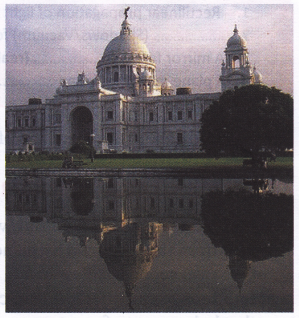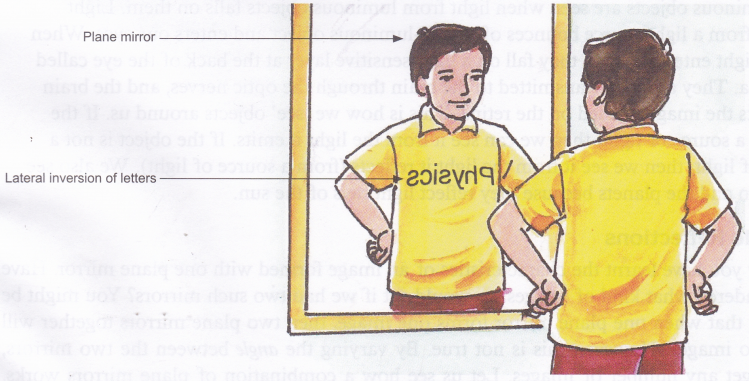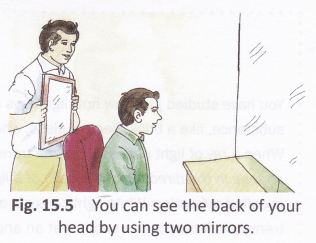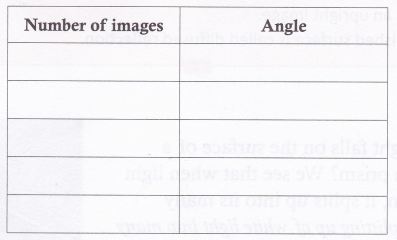Image Reflection by a Plane Mirror
Can you think of a plane reflecting surface? The mirror on the dressing table is a good example of a plane reflecting surface. Any smooth polished surface that can reflect the rays of light and form a clear image is called a mirror. Any highly polished metal surface, e.g., a steel plate or still water.

If you look at yourself closely in a mirror, what do you observe about your image? Is it bigger or smaller than you?
Place the palm of your hand on the flat surface of the mirror and study its reflected image. Is the image bigger, smaller, or of the same size?
Now move your hand slowly away from the mirror and observe the size of the image all the time. You will find that the size of the image neither increases nor decreases in size. However, as you move your hand away from the mirror, the image also moves away. The image is at the same distance behind the mirror as the object (here your hand is the object) in front of it.

Now stand in front of the mirror and see if you can touch your image formed in the mirror. You cannot because the image seems to be behind the mirror. Such an image is called a virtual image. A virtual image cannot be formed on a screen. Do you notice anything else about your image? Is the image upside down as compared to you? It is not. Such an image is called an upright image. Thus, a reflecting surface produces an image of certain properties. These are called image characteristics. To summarize, the image characteristics of a plane mirror are:
Size: Look at yourself in a dressing mirror. Move back and forth. Look at the images of the various objects around you. Do you feel that the images are enlarged or diminished (i.e., increased or decreased in size) as compared to the size of the object? You will find that the image size and the object size are the same.
Upright or inverted: This one is really easy! When you see yourself in the mirror every morning, do you see yourself standing upright, or do you see yourself inverted with your feet pointing to the ceiling of the room? You see yourself upright. In other words, a plane mirror forms an upright (also called erect) image.
The distance of the image (from the mirror) as compared to that of the object: Stand in front of the mirror and then move back and forth. Observe the image closely. What do you see? You will see that when you move closer to the mirror, your image also seems to move closer. And when you move away from the mirror, your image also seems to move farther away. This is because, in a plane mirror, the distance of the image (from the mirror) equals the distance of the object from the mirror.
Lateral inversion (left-right reversal): Write your name on a sheet of paper and hold it in front of a mirror. What do you see? You will see that your name has been completely reversed. Furthermore, some letters also look peculiar. This happens because the reflected image undergoes left-right inversion, also called lateral inversion.

People also ask
- What is Reflection of Light?
- Analysing Reflection of Waves
- Application of Reflection of Light in Daily Life
- What is the Law of Reflection of Light?
- What do you mean by Total Internal Reflection?
- Applications of Total Internal Reflection
- Which Type of Image is Formed by a Plane Mirror?
- Is an Image formed by Reflection Real or Virtual
- Reflection of Light from Spherical Mirror
- What are Concave and Convex Mirrors?
- How is Focal Length related to Radius of Curvature?
- How is the Image Formed by a Spherical Mirror?
Multiple Reflections
Have you wondered what kind of images we would get if we had two such mirrors? You might be thinking that when one plane mirror forms one image, then two plane mirrors together will , form two images. However, this is not true. By varying the angle between the two mirrors, we can get any number of images. Let us see how a combination of plane mirrors works.
 For example, if we keep two plane mirrors at an angle of 90° to each other, we will get three images. As we decrease the angle between the mirrors, the number of images will increase. When the two mirrors are parallel to each other (angle 0°), we get an infinite number of images. You might have observed this in many places. Some elevators (lifts) have mirrored walls. If you try to look at yourself in one mirror, which has a parallel mirror on the opposite wall, you will see that there are an infinite number of images! head by using two mirrors. Have you ever tried to look at the back of your head in a mirror? If you have, you will know that you need two mirrors to be able to see the back of your own head. This is again a case of multiple reflections of light.
For example, if we keep two plane mirrors at an angle of 90° to each other, we will get three images. As we decrease the angle between the mirrors, the number of images will increase. When the two mirrors are parallel to each other (angle 0°), we get an infinite number of images. You might have observed this in many places. Some elevators (lifts) have mirrored walls. If you try to look at yourself in one mirror, which has a parallel mirror on the opposite wall, you will see that there are an infinite number of images! head by using two mirrors. Have you ever tried to look at the back of your head in a mirror? If you have, you will know that you need two mirrors to be able to see the back of your own head. This is again a case of multiple reflections of light.
Aim: To observe the images formed with two plane mirrors when they are placed at different angles to each other.
Materials needed: Two plane mirrors and a small object (like a pen cap)
Method:
- Keep the two mirrors side by side so that they are in a straight line.
- Place the small object (pen cap) in front of the mirrors. How many images do you see?
- Now reduce the angle between the two mirrors slowly. Observe the images.
Observation: When you keep the two mirrors side by side, you will see only one image as the two mirrors together act as one. You will see that as soon as you reduce the angle between the mirrors, two images appear. When the angle is reduced further, you will get three images. As the angle between the mirrors is reduced further, more and more images can be seen.
Extension: Start again from the beginning (i.e., the two mirrors in a straight line) and hold the mirror still when the second image just begins to appear (two full images, not two disjointed images). Hold the mirrors at this position and ask a friend to trace the outline of the base of the mirrors. Remove the mirrors and measure the angle with a protractor. Repeat this for three, four, and five images. Make a table as shown below.
 The number of images (N) formed with two plane mirrors kept at an angle ‘a’ to each other is given by the formula N = (360/a) – 1. Check to see if this formula holds true.
The number of images (N) formed with two plane mirrors kept at an angle ‘a’ to each other is given by the formula N = (360/a) – 1. Check to see if this formula holds true.
